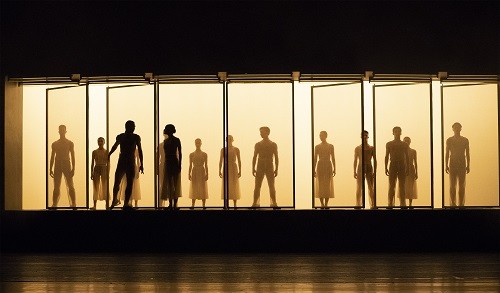 United Kingdom Various composers, Polarity & Proximity: Dancers of Birmingham Royal Ballet, Royal Ballet Sinfonia / Jonathan Lo (Kin.) and Koen Kessels (Embrace), Sadler’s Wells, London, 15.6.2018. (JO’D)
United Kingdom Various composers, Polarity & Proximity: Dancers of Birmingham Royal Ballet, Royal Ballet Sinfonia / Jonathan Lo (Kin.) and Koen Kessels (Embrace), Sadler’s Wells, London, 15.6.2018. (JO’D)

Kin.
Music – Phil Kline
Choreography – Alaxander Whitely
Designs – Jean-Marc Puissant
Lighting – Peter Teigen
Embrace
Music – Sarah Kirkland
Choreography – George Williamson
Designs – Madeleine Girling
Lighting – Peter Teigen
In the Upper Room
Music – Philip Glass
Choreography – Twyla Tharp
Original Costume designs – Norma Kamali
Original Lighting – Jennifer Tipton
Fast-moving, complex and danced to the pulsating, recorded music of Philip Glass: how could Twyla Tharp’s 42-minute long In the Upper Room (1992) not send the audience out of Sadler’s Wells in an excited buzz of admiration and praise? While the preceding works in Birmingham Royal Ballet’s Polarity & Proximity triple bill were strong in terms of design, music, lighting and execution, neither had achieved such satisfying overall effect.
For the first three of its four sections it seemed that Alexander Whitley’s Kin. (2014) was going to be the work by this choreographer that did not run into sand. Jean-Marc Puissant provides an intriguing setting (lit in shades of purple by Peter Teigen): three double doors, like those that might be found in a nineteenth-century French apartment, and bare walls. The ten dancers, who might represent a family, are all in black, neatly cut to allow freedom of movement.
Dancers in work by Alexander Whitley use the floor, as if it were a partner, to support their legs and arms. In the third section of this piece, the ballet-trained choreographer also includes an extended sequence of the bourrée couru, for Jenna Roberts. The duet that follows, with Joseph Caley, has a force that suggests it is the climax, the end. Some people in the audience applaud. When the lights come on again for a fourth section, Tzu-Chao Chou, alone on the stage, has to restart something that has stalled.
Brandon Lawrence, who came to the fore briefly, but remarkably, in Kin. takes centre stage for George Williamson’s Embrace (2018). He is a dancer whose body seems to have some extra feeling, in its nerve endings perhaps. An androgynous quality, to a turned-in knee for example, brings both Gene Kelly and Marilyn Monroe to mind. George Williamson exploits this by giving him the role of a young man, He, attracted to Him (Max Maslen) and She (Delia Mathews).
Duets by the three lead dancers captivate the audience. Madeleine Girling’s costumes of loose transparent white over tighter-fitting fuchsia actively suggest inner and outer selves. But the work makes too much use of its set (a raised platform and screens, by Girling, with lighting again by Teigen). The choreography for Self One, Self Two, Self Three and an ensemble, Them, lacks clarity: too much coming and going of dancers, as in the Williamson’s Firebird for English National Ballet in 2012. Embrace leaves you feeling it would be better reworked as a shorter piece for a smaller cast.
Several seats in the auditorium that had been occupied were vacant after the second interval when In the Upper Room began. For a while, its dancers had to overcome this emptiness. It did not take them long. Ruth Brill gave a demonstration of musicality and precision. The audience gasped, then gave itself up to Twyla Tharp’s post-modern, break-neck eclecticism. Classical ballet, tap, rodeo, chorus line; wrists, ankles, bottoms: every possible movement style, every part of the body comes into play. Running on from the wings, or from haze that obscures the back of the stage, dancers dressed in baggy, black-and-white stripes and touches of red, met the challenge of choreography that came to express, from the perspective of 2018, an almost moving sense of hopefulness and fun.
John O’Dwyer
